Related Research Articles

Alexander III of Macedon, most commonly known as Alexander the Great, was a king of the ancient Greek kingdom of Macedon. He succeeded his father Philip II to the throne in 336 BC at the age of 20 and spent most of his ruling years conducting a lengthy military campaign throughout Western Asia, Central Asia, parts of South Asia, and Egypt. By the age of 30, he had created one of the largest empires in history, stretching from Greece to northwestern India. He was undefeated in battle and is widely considered to be one of history's greatest and most successful military commanders.
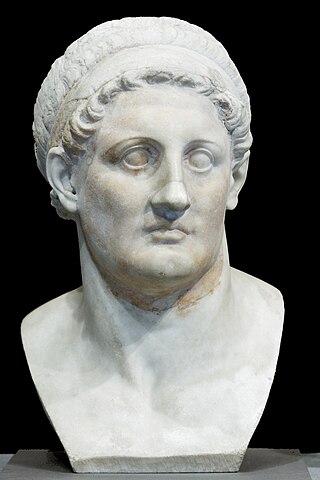
Ptolemy I Soter was a Macedonian Greek general, historian, and successor of Alexander the Great who went on to found the Ptolemaic Kingdom centered on Egypt and led by his progeny from 305 BC – 30 BC. Ptolemy was basileus and pharaoh of Ptolemaic Egypt from 305/304 BC to his death, during which time Egypt became a thriving bastion of Hellenistic civilization and Alexandria a great seat of Greek culture.
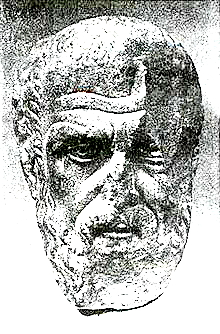
Arrian of Nicomedia was a Greek historian, public servant, military commander, and philosopher of the Roman period.

Nearchus or Nearchos was one of the Greek officers, a navarch, in the army of Alexander the Great. He is known for his celebrated expeditionary voyage starting from the Indus River, through the Persian Gulf and ending at the mouth of the Tigris River following the Indian campaign of Alexander the Great, in 326–324 BC.
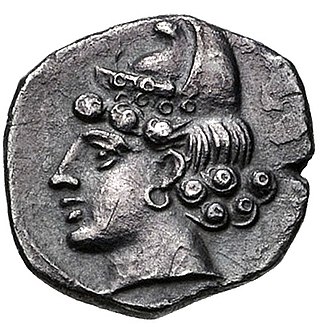
Arses, also known by his regnal name Artaxerxes IV, was the twelfth Achaemenid King of Kings from 338 to 336 BC.
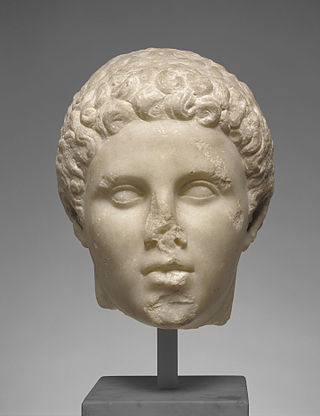
Hephaestion, son of Amyntor, was an ancient Macedonian nobleman of probable "Attic or Ionian extraction" and a general in the army of Alexander the Great. He was "by far the dearest of all the king's friends; he had been brought up with Alexander and shared all his secrets." This relationship lasted throughout their lives, and was compared, by others as well as themselves, to that of Achilles and Patroclus.

The Battle of Gaugamela, also called the Battle of Arbela, took place in 331 BC between the forces of the Army of Macedon under Alexander the Great and the Persian Army under King Darius III. It was the second and final battle between the two kings, and is considered to be the final blow to the Achaemenid Empire, resulting in its complete conquest by Alexander.

The wars of Alexander the Great were a series of conquests that were carried out by Alexander III of Macedon from 336 BC to 323 BC. They began with battles against the Achaemenid Persian Empire, then under the rule of Darius III of Persia. After Alexander's chain of victories against Achaemenid Persia, he began a campaign against local chieftains and warlords that stretched from Greece to as far as the region of Punjab in South Asia. At the time of his death, he ruled over most regions of Greece and the conquered Achaemenid Empire ; he did not, however, manage to conquer the Indian subcontinent in its entirety according to his initial plan. Despite his military accomplishments, Alexander did not provide any stable alternative to the rule of the Achaemenid Empire, and his untimely death threw the vast territories he conquered into a series of civil wars, commonly known as the Wars of the Diadochi.

The Battle of the Hydaspes also known as Battle of Jhelum, or First Battle of Jhelum, was fought between Alexander the Great and Porus in May of 326 BC. It took place on the banks of the Hydaspes River in Punjab, as part of Alexander's Indian campaign. In what was possibly their most costly engagement, the Macedonian army secured a decisive victory over the Pauravas and captured Porus. Large areas of Punjab were subsequently absorbed into the Macedonian Empire; Porus was reinstated as the region's ruler after Alexander, having developed a newfound respect for the fierce resistance put up by Porus and his army, appointed him as a satrap.

The Battle of the Granicus in May 334 BC was the first of three major battles fought between Alexander the Great of Macedon and the Persian Achaemenid Empire. The battle took place on the road from Abydus to Dascylium, at the crossing of the Granicus in the Troad region, which is now called the Biga River in Turkey. In the battle Alexander defeated the field army of the Persian satraps of Asia Minor, which defended the river crossing. After this battle, the Persians were forced on the defensive in the cities that remained under their control in the region.

The Anabasis of Alexander was composed by Arrian of Nicomedia in the second century AD, most probably during the reign of Hadrian. The Anabasis is a history of the campaigns of Alexander the Great, specifically his conquest of the Persian Empire between 336 and 323 BC. Both the unusual title "Anabasis" and the work's seven-book structure reflect Arrian's emulation of the Greek historian Xenophon, whose own Anabasis in seven books concerned the earlier campaign "up-country" of Cyrus the Younger in 401 BC.
Parmenion, son of Philotas, was a Macedonian general in the service of Philip II of Macedon and Alexander the Great. A nobleman, Parmenion rose to become Philip's chief military lieutenant and Alexander's strategos. He was assassinated after his son Philotas was convicted on a charge of treason. His siblings Asander and Agathon would also become prominent members of Alexander's Macedonia.

Alexandria Eschate was a city founded by Alexander the Great, at the south-western end of the Fergana Valley in August 329 BC. It was the most northerly outpost of Alexander's Empire in Central Asia. Alexandria Eschate was established on the south bank of the river Jaxartes, at or close to the site of modern Khujand. According to the Roman writer Curtius, Alexandria Ultima retained its Greek culture as late as 30 BC.

The Kabul River, the classical Cophen, is a river that emerges in the Sanglakh Range of the Hindu Kush mountains in the northeastern part of Maidan Wardak Province, Afghanistan. It is separated from the watershed of the Helmand River by the Unai Pass. The Kabul River is a tributary of the Indus River, flowing into it near Attock, Pakistan. The Kabul is the main river in eastern Afghanistan and in the Khyber Pakhtunkhwa province of Pakistan.

Taxiles or Taxilas was the Greek chroniclers' name for the ruler who reigned over the tract between the Indus and the Jhelum (Hydaspes) Rivers in the Punjab region at the time of Alexander the Great's expedition. His real name was Ambhi, and the Greeks appear to have called him Taxiles or Taxilas, after the name of his capital city of Taxila, near the modern city of Attock, Pakistan.

Myndus or Myndos was an ancient Dorian colony of Troezen, on the coast of Caria in Asia Minor, (Turkey), sited on the Bodrum Peninsula, a few miles northwest of Halicarnassus. The site is now occupied by the modern village of Gümüşlük.

Aria was an Achaemenid region centered on the city of Herat in present-day western Afghanistan. In classical sources, Aria has been several times confused with the greater region of ancient Ariana, of which Aria formed a part.

The Battle of the Persian Gate took place as part of the Wars of Alexander the Great. In the winter of 330 BC, Ariobarzanes of Persis led a last stand with his outnumbered Persian army at the Persian Gate, near Persepolis, and held back the Macedonian army for approximately a month. However, through captured prisoners of war or a local shepherd, Alexander found a path around to flank the Persian troops from the rear, allowing him to capture half of Persia proper in another decisive victory against the Achaemenid Empire.

The Indian campaign of Alexander the Great began in 327 BC and lasted until 325 BC. After conquering the Achaemenid Persian Empire, the Macedonian army undertook an expedition into the northwestern Indian subcontinent. Within two years, Alexander expanded the Macedonian Empire to include present-day Punjab and Sindh in what is modern-day Pakistan, surpassing the earlier frontiers that had been established by the Persian conquest of the Indus Valley.
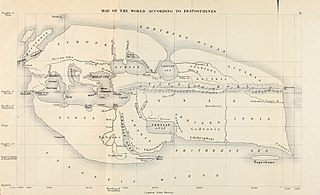
Homonoia is the concept of order and unity, being of one mind together or union of hearts. It was used by the Greeks to create unity in the politics of classical Greece. It saw widespread use when Alexander the Great adopted its principles to govern his vast Empire.
References
- 1 2 3 4 5 6 7 8 9 10 11 12 13 14 15 16 17 18 19 20 21 22 23 24 25 26 27 28 29 30 31 32 33 34 35 36 37 38 39 40 41 42 43 44 45 46 47 48 49 50 51 52 53 54 55 56 57 58 59 60 61 62 63 64 65 66 67 68 69 70 71 72 73 74 75 76 77 78 79 80 81 82 83 84 85 86 87 88 89 90 91 92 93 94 95 96 97 98 99 100 101 102 103 104 105 106 107 108 109 110 111 112 113 114 115 116 117 118 119 120 121 122 123 Arrian, John Rooke (1813). Arrian's History of the expedition of Alexander the Great: and conquest of Persia. J. Davis. p. 256.
- 1 2 3 4 5 6 7 8 9 10 11 12 13 14 15 16 17 18 19 20 21 22 23 24 25 26 27 28 29 30 31 32 33 34 35 36 37 38 39 40 41 42 43 44 45 46 47 48 49 50 51 52 53 54 55 56 57 58 59 60 61 62 63 64 65 66 67 68 69 70 71 72 73 74 75 76 77 78 79 80 81 82 83 84 85 86 87 88 89 90 91 92 93 94 95 96 97 98 99 100 101 102 103 104 105 106 107 108 109 110 111 112 113 114 115 116 117 118 Nigel Cawthorne (2004). Alexander the Great. Haus Publishing. p. 156. ISBN 978-1-904341-56-7.
- 1 2 3 4 5 6 7 8 9 10 11 12 13 14 15 16 17 18 19 20 21 22 23 24 25 26 27 28 29 30 31 32 33 34 35 36 37 38 39 40 41 42 43 44 45 46 47 48 49 50 51 52 53 54 55 56 57 58 59 60 61 62 63 64 65 66 67 68 69 70 71 72 73 74 75 76 77 78 79 80 81 82 83 84 85 86 87 88 89 90 91 92 93 94 95 96 97 98 99 100 101 102 103 104 105 106 107 108 109 110 111 112 113 114 115 116 117 118 Waldemar Heckel (2003). The wars of Alexander the Great, 336-323 B.C. Taylor & Francis. p. 13. ISBN 978-0-415-96855-3.
- 1 2 3 4 5 6 7 8 9 10 11 12 13 14 15 16 17 18 19 20 21 22 23 24 25 26 27 28 29 30 31 32 33 34 35 36 37 38 39 40 41 42 43 44 45 46 47 48 49 50 51 52 53 54 55 56 57 58 59 60 61 62 63 64 65 66 67 68 69 70 71 72 73 74 75 76 77 78 79 80 81 82 83 84 85 86 87 88 89 90 91 92 93 94 95 96 97 98 99 100 101 102 103 104 105 106 107 108 109 110 111 112 113 114 115 116 117 118 Arrian, James S.; Romm, Pamela Mensch (2005). Alexander the Great: selections from Arrian, Diodorus, Plutarch, and Quintus Curtius. Hackett Publishing. p. 22. ISBN 978-0-87220-727-1.